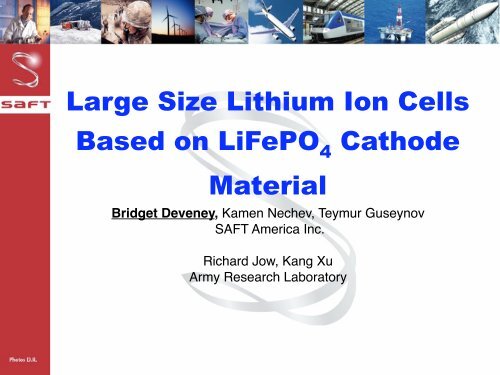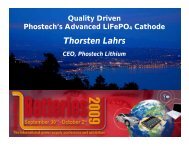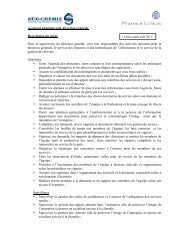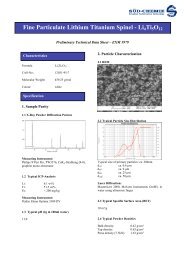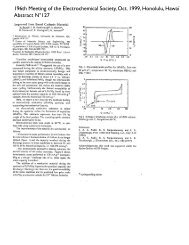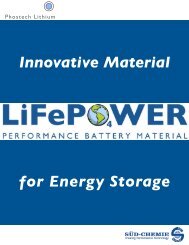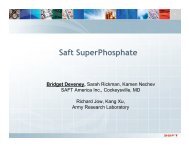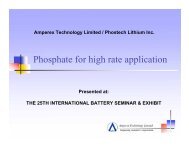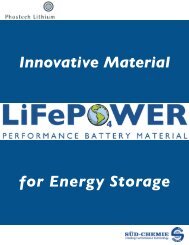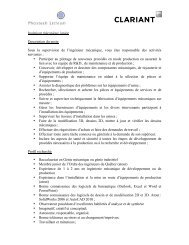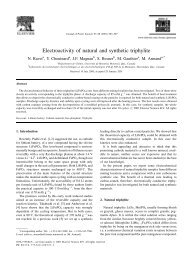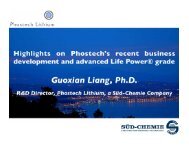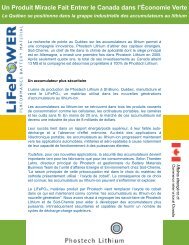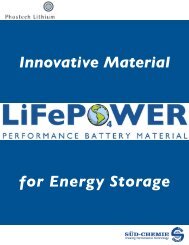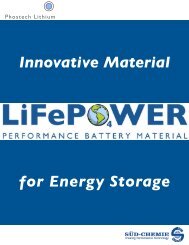Large Size Lithium Ion Cells Based on LiFePO Cathode Material
Large Size Lithium Ion Cells Based on LiFePO Cathode Material
Large Size Lithium Ion Cells Based on LiFePO Cathode Material
You also want an ePaper? Increase the reach of your titles
YUMPU automatically turns print PDFs into web optimized ePapers that Google loves.
<str<strong>on</strong>g>Large</str<strong>on</strong>g> <str<strong>on</strong>g>Size</str<strong>on</strong>g> <str<strong>on</strong>g>Lithium</str<strong>on</strong>g> <str<strong>on</strong>g>I<strong>on</strong></str<strong>on</strong>g> <str<strong>on</strong>g>Cells</str<strong>on</strong>g><br />
<str<strong>on</strong>g>Based</str<strong>on</strong>g> <strong>on</strong> <strong>LiFePO</strong> 4<br />
<strong>Cathode</strong><br />
<strong>Material</strong><br />
Bridget Deveney, Kamen Nechev, Teymur Guseynov<br />
SAFT America Inc.<br />
Richard Jow, Kang Xu<br />
Army Research Laboratory
<strong>LiFePO</strong> 4<br />
Development<br />
Ir<strong>on</strong> Phosphate is an emerging <strong>Cathode</strong> material for Li-i<strong>on</strong>.<br />
Advantages in abuse tolerance<br />
Cost in energy density and power<br />
Phostech is currently the <strong>on</strong>ly licensed supplier of the UT<br />
technology.<br />
<br />
In 2005 Cockeysville initiated working <strong>on</strong> <strong>LiFePO</strong> 4 under a developmental<br />
program with Army research laboratory<br />
Research provided guidance and cathode materials based <strong>on</strong> at least 2 years of<br />
prior explorati<strong>on</strong> of the technology<br />
Cockeysville based the development effort <strong>on</strong> its high power electrode design<br />
expertise<br />
<br />
<br />
Currently Cockeysville is c<strong>on</strong>tinuing the <strong>LiFePO</strong> 4 development under<br />
MANTECH (US Army) funded effort. Two cell sizes (VLV and VLP) have<br />
been built and are in testing.<br />
As requested by the customer a module c<strong>on</strong>taining Very High Power cell<br />
with the <strong>LiFePO</strong> 4 cathode was delivered in December 2006 and subjected<br />
to a bullet test.<br />
Saft Proprietary
VL10Fe Cell <str<strong>on</strong>g>Based</str<strong>on</strong>g> On <strong>LiFePO</strong> 4<br />
<strong>Cathode</strong><br />
Cell optimized for Very High<br />
Power applicati<strong>on</strong>s<br />
SAFT is using licensed<br />
supplier for the Ir<strong>on</strong> Phosphate<br />
cathode material<br />
Saft Proprietary
VL25Fe Cell <str<strong>on</strong>g>Based</str<strong>on</strong>g> On <strong>LiFePO</strong> 4<br />
<strong>Cathode</strong><br />
Cell optimized for Medium<br />
Power/Medium Energy<br />
applicati<strong>on</strong>s<br />
SAFT is using licensed<br />
supplier for the Ir<strong>on</strong> Phosphate<br />
cathode material<br />
Saft Proprietary
<strong>LiFePO</strong> 4<br />
Development: Capacity and Energy<br />
Total Energy Delivered Compared to a standard VL12V (NCA cathode):<br />
75% of VL12V Energy at 12Amps 50% of the VL12V Energy at 1500Amps<br />
Saft Proprietary
<strong>LiFePO</strong> 4<br />
Development: Power<br />
VL10Fe 5400W/kg SECOND MOST POWERFUL CELL<br />
AFTER SAFT VL-V CHEMISTRY<br />
Saft Proprietary
<strong>LiFePO</strong> 4<br />
Development: Low Temperature<br />
Saft Proprietary
<strong>LiFePO</strong> 4<br />
Development: Life<br />
Cycling of VL10Fe<br />
30°C- projected 4400 cycles to 80% capacity, 5700 cycles to 75%<br />
45°C-1800 cycles to 80% capacity, 2300 cycles to 75%<br />
60°C- 700 cycles to 80% capacity, projected 1150 cycles to 75%<br />
Saft Proprietary
<strong>LiFePO</strong> 4<br />
Development: Life<br />
Pulse Power retenti<strong>on</strong> with ageing<br />
2500 W/kg 18sec Discharge PP @ (70-100)% SOC & 25°C<br />
1900 W/kg 18sec Charge PP @ (20-80)% SOC & 25° C<br />
Nearly no power loss after 700 full cycles @ 1C rate & 60°C<br />
Discharge PP<br />
Charge PP<br />
Saft Proprietary
<strong>LiFePO</strong> 4<br />
Development: Life<br />
Very little loss of low temperature power after cycling at<br />
high temperature<br />
Saft Proprietary
<strong>LiFePO</strong> 4<br />
Development: Safety<br />
0.63 mOhm Short Circuit<br />
No event<br />
T
<strong>LiFePO</strong> 4<br />
Development: Abuse Testing<br />
25A/24V Overcharge<br />
Smoke, No flame<br />
Max temp 310°C<br />
Slow Nail at 100% SOC<br />
Smoke, No Flame<br />
Max Temp 120°C<br />
VL25Fe cells abuse testing: No fire with slow nail or overcharge<br />
Saft Proprietary
<strong>LiFePO</strong> 4<br />
Development : C<strong>on</strong>clusi<strong>on</strong><br />
Saft cells are the highest power Ir<strong>on</strong> Phosphate cells<br />
available today<br />
In all this work SAFT is using material from the <strong>on</strong>ly licensed<br />
by UT supplier of <strong>LiFePO</strong> 4 – Phostech/Süd-Chemie.<br />
Saft Ir<strong>on</strong> Phosphate is suitable for power applicati<strong>on</strong>s that<br />
require an added level of redundant safety<br />
The requirements of the applicati<strong>on</strong> must be c<strong>on</strong>sidered as<br />
there are tradeoffs in:<br />
• Power & energy<br />
• Low temperature performance<br />
• Less robust at high temperature for storage<br />
• Weight and Volume<br />
The overall requirements of the applicati<strong>on</strong> must be taken<br />
into account to design the ideal total soluti<strong>on</strong><br />
Saft Proprietary
Acknowledgements<br />
Saft would like to thank Gus Khalil, Henry Catherino, and<br />
S<strong>on</strong>ya Gargies at US Army TARDEC for c<strong>on</strong>tinued support<br />
of <strong>on</strong>going developmental efforts under the ManTech<br />
program.<br />
Saft would also like to thank Dr. Richard Jow of ARL for his<br />
c<strong>on</strong>tinued guidance and support and insight into new<br />
materials and performance improvements.<br />
Saft Proprietary


